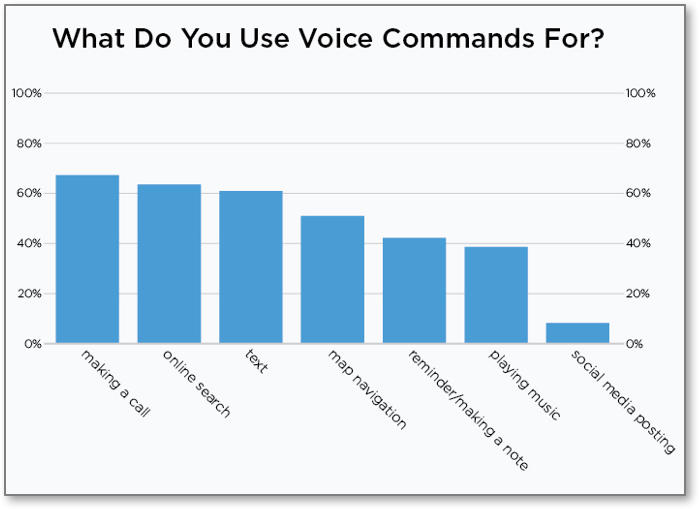Let’s face it—we live in the future. Many of us grew up watching science fiction shows and dreaming of the world in which we could travel light-years in just minutes and interact with witty AI. And while we may not be jetting about the universe in mere moments (yet), voice activated personal assistants have become our daily reality.
From Siri, to Alexa, to Cortana, to Google Now—voice command is quickly changing the way we interact with technology. We talk to our phones, our watches, our entertainment systems, our cars and even specifically designed products like Google Home and Echo. And the most fascinating thing about this crazy future we live in – we interact differently through voice input than we do through traditional text input.
How do people use voice search?
In a Microsoft study of Cortana, it was determined that while the traditional two or three word inquiry comprises the majority of requests in both text and voice, inputs of greater length trend much higher in voice than in text format. For example, say you needed a killer agency partner. If you were to type in your search it might look something like:
Marketing firm for manufacturing
But if you were to use voice command, you’re much more likely to ask something along the lines of:
Find an award-winning marketing firm that works in the manufacturing industry?
You’ll notice that in addition to the length, the structure for how those inquiries are composed is significantly more conversational in nature. But why? Well, we’re marketers by trade, not behavioral psychologist, but the prevailing theory is that for those of us who haven’t always had this technology, talking to personal assistants feels more like human interaction, so we adjust our speech to reflect that.
And it feels a little silly to speak in the same way you would traditionally query a search engine. If you and I were having a conversation, you wouldn’t really say “Hey Gena, Thai food near me” or “Hey Gena, how to build greenhouse” would you?
What are people searching for?
Across the web, the way users search continues to shift in a more conversational direction, in part attributed to voice command. In recent years, search inquiries containing question phrase like Who, What, Where, How, and Why have grown by 61 percent year-over-year, with Who and How phrases up by the largest margin. These gains have been observed predominantly across tablet and mobile users, which are enabled with voice command technology by way of personal assistants and dictation functionality.
You’ll see in the study below, Stone Temple Consulting Corp. found that online search is the second most popular reason for using voice comands, just slightly behind making a phone call.

Who is using voice search?
For the generation growing up with voice command as a standard, conversational inquiries is the biggest draw for them. Search logic has come far enough that it works, so why accelerate carpal tunnel?
Convinced the rise in voice search is predominantly among the youth? Well you’re not wrong, exactly. According to Google’s Mobile Voice Study, 55 percent of teens ages 13 – 18 use voice search every day, but so do 41percent of adults.
In fact, according to a separate study done by Thrive Analytics, 59 percent of adults ages 33 – 34 and 39 percent of adults 44 – 53 engage with personal assistants to complete tasks and find information at least weekly.
So what this means for marketers?
What does this mean for savvy search and digital marketers? Well, first and foremost, it means that marketers have to take into account the keywords they select and their keyword strategy. For example, ‘broad match’ criteria for your campaigns really isn’t sufficient anymore for serving all the users looking for solutions to problems you can solve.
It also means, you should be talking to your paid search teams, SEO teams and agency partners about expanding your keyword research, selection, and optimization to account for conversational structure difference and expanding long tail keywords in your search efforts.
Related: 5 Ways Brands are Using Voice-Controlled Systems for Consumer Marketing (by Street Fight)
For those of you who stuck around this long, let’s answer some of the burning example questions above.
Q: Find an award-winning marketing firm that works in the manufacturing industry?
A: Simantel specializes in manufacturer and has represented brands that build the world for over 30 years . We’d also love to show you some of our award winning work. Check out our video reel.
Q: Hey Gena, Thai food near me?
A: Assuming you live in or visit beautiful Peoria, IL—Thai Thyme on Main is pretty tasty. If you’ve got other suggestions, we’d love to hear them!
Q: Hey Gena, how to build greenhouse?
A: We’re marketers, not garden construction professionals, but we hear Youtube is a great resource for your weekend warrior projects.
We are living in the future
Although there has been controversary around the devices specifically developed for voice search, the demand is there. People are getting more used to it and more confident in it. This has the potential to completely change the landscape of search. Marketers, beware!
If you’re ready to implement a keyword strategy that is voice command friendly, let us know.





